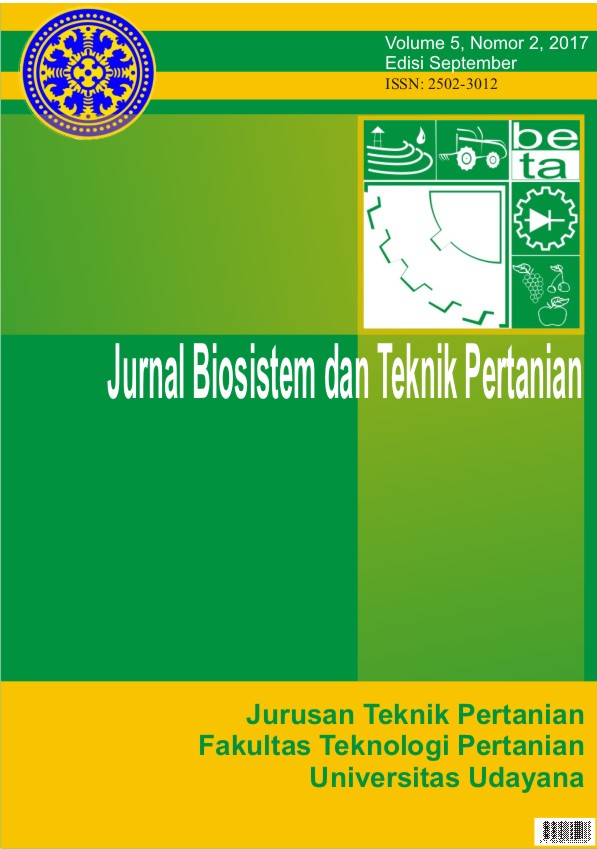Pengaruh Pemberian Uap Etanol dan Emulsi Lilin Lebah Terhadap Mutu dan Masa Simpan Buah Salak Gulapasir
Abstract
Tujuan dari penelitian ini adalah untuk mengetahui pengaruh pemberian uap etanol dengan konsentrasi larutan yang berbeda dan konsentrasi emulsi lilin lebah yang berbeda, sebagai bahan pelapis terhadap mutu serta masa simpan salak Gulapasir dan menentukan ragam konsentrasi yang tepat untuk mempertahankan mutu buah salak Gulapasir. Penelitian ini menggunakan rancangan acak kelompok faktorial dengan dua faktor yaitu perlakuan etanol dengan 3 tingkat konsentrasi (0%, 10% dan 20%) dan konsentrasi emulsi lilin lebah (0%, 1%, 2%, dan 3%). Salak Gulapasir sebagai kontrol disiapkan tanpa perlakuan etanol dan pelapisan lilin lebah. Percobaan dikelompokkan menjadi tiga kelompok. Pengamatan dilakukan setiap lima hari sampai hari ke 15. Parameter yang diamati meliputi susut bobot, kekerasan, total padatan terlarut, total asam titrasi, intensitas kerusakan, color difference dan uji organoleptik. Hasil sidik ragam menunjukan bahwa interaksi perlakuan uap etanol dan pelapisan lilin lebah berpengaruh nyata terhadap susut bobot, kekerasan, intensitas kerusakan, color difference, dan uji organoleptik rasa, aroma warna sedangkan tidak berpengaruh nyata terhadap total padatan terlarut dan total asam. Kombinasi perlakuan etanol dengan konsentrasi 20% (E20) dengan pelapisan 1% (K1) dengan karakteristik yang dihasilkan nilai rata-rata susut bobot 21,04%, kekerasan 37,34 N, intensitas kerusakan 6,79%, total padatan terlarut 21,04 0Brix, total asam 0.59%, color difference 26,14. Demikian pula uji organo memiliki nilai rata-rata dari panelis untu rasa 3,57, aroma 3,27, dan warna 3.51.
The aim of this study is to know the effect of ethanol vapor with different consentration and different concentration of beeswax emulsion, as a coating material that can preserve the quality and shelf life of salak Gulapasir. This research used a factorial randomized block design with two factors which are ethanol vapor treatment with 3 levels of concentrations (0%, 10% and 20%) and variety concentration of beeswax emulsion (0%, 1%, 2%, and 3%). Salak Gulapasir as control were prepared without treatment of ethanol vapor and beeswax emulsion, as a coating material. The experiment were devided into three groups. The observation is perfomed every five days until fifteenth day. The observed parameter of this research were weight loss, hardness, intensity of damage, total dissolved solids, total titrated acids, color difference and organoleptic test. The result of variance analysis showed that the interaction between ethanol vapor and beewax coating significantly affect the weight loss, hardness, intensity of damage, color difference, and organoleptic test. Whereas no significantly affect on total dissolved solids and total titrated acids. The combination of ethanol vapor of 20% (diluted in the water) and 1% concentration of beeswax emulsion as a coating material with the resulting characteristic weighted mean value of 21.04%, hardness 37.34 N, intensity of damage 6.79%, total dissolved solids 21, 04 0Brix, total acid 0.59%, color difference 26.14. Similarly, the organoleptic test has an average value of panelist for taste of 3.57, aroma 3.27, and color 3.51.
Downloads
References
Davies, D.D., 1980. Anaerobic metabolism and the production of organic acids. In: PK. Stumpf and E.E. Conn (Editors), The Biochemistry of Plants, A Comprehensive Treatise, Volume 2. Academic Press, New York, N.Y., pp. 581-611.
Elwahab, S.M.A., and I.A.S. Rashid. 2013. Using Etanol, Cinnamon Oil Vapors And Waxing As Natural Safe Alternatives For Control Postharvest Decay, Maintain Quality And Extend Marketing Life Of Mandarin. J. Agr. Bio. Sci. 9(1): 27-39.
Kelly, M.O. and Saltveit, M.E., 1988. Effect of endogenously synthesised and exogenously applied ethanol to tomato fruit ripening. Plant Physiol., 88: 143-147.
Kremer, Fr. & Unterstenhofer, G. (1967): De l’ emploi de la metode de Townsend et Heuberger dans l’interpretation de results d’essais phytosanitares. Pflanzenschutz Nachrichten, Bayer 4: 625–628.
Kumalaningsih, S dan Hidayat, N. 1995. Mikrobiologi Hasil Pertanian. Institut Keguruan dan Ilmu Pendidikan, Malang.
Nugroho,W. 2002. Pengaruh Pelilinan terhadap Kualitas dan Daya Simpan Buah Durian (Durio zibhetinus Murr.) Varietas Rancamaya pada Suhu Kamar. Skripsi. Jurusan Teknik Pertanian. IPB. Bogor.
Patras, A., Brunton, N. P., Tiwari, B., & Butler, F. (2011). Stability and degradation kinetics of bioactive compounds and colour in strawberry jam during storage. Food and Bioprocess Technology, 4, 1245–1252.
Rachmawati, M. 2010. Kajian Sifat Kimia Salak Pondoh (Salacca edulis Reinw) Dengan Pelapisan Khitosan Selama Penyimpanan Untuk Mempreduksi Masa Simpannya.Jurnal Teknologi Pertanian 6 (1). Halaman 20-24.
Rhim, J.,Wu, Y.,Weller, C., & Schnepf, M. (1999). Physical characteristics of a composite film of soy protein isolate and propyleneglycol alginate. Journal of Food Science, 64(1), 149–152.
Steel R. G. D & Torrie J. H. 1993. Prinsip dan Prosedur Statistik. Gramedia Pustaka Media, Jakarta.
Waryat dan M. Rahmawati. 2010. Pemanfaatan Chitosan untuk Mempertahanakan Buah Salak Pondoh (Salacca zalacca cv. Pondoh). Prosiding Seminar Nasional: Teknologi Inovatif Pascapanen untuk Pengembangan lndustri Berbasis Pertanian, Balai Besar Penelitian dan Pengembangan Pascapanen Pertanian. Bogor.
Wijana, G. 1990. Telaah sifat-sifat buah salak Gulapasir sebagai dasar penggunaannya. Fakultas Pascasarjana, Institut Pertanian Bogor. pp. 163.
Wills, Graham, Glason MC, Hall. 1981. Postharvest an Introduction of Fruits and Vegetables. London: Granada.
Wolfe, T.K. dan Kipps, M.S. 1953. Production of Field Crops. A Textbook of. McGraw-Hill Book Company, Inc. New York.












 Jurnal BETA (Biosistem dan Teknik Pertanian)
Jurnal BETA (Biosistem dan Teknik Pertanian)


